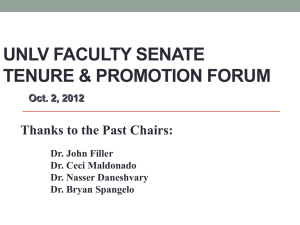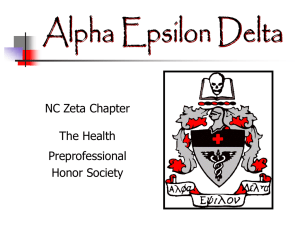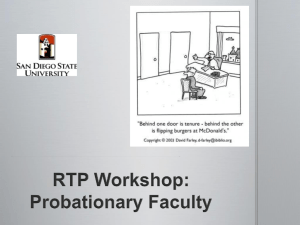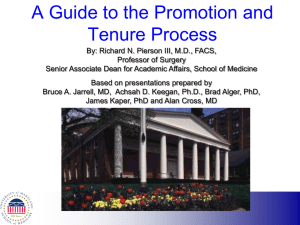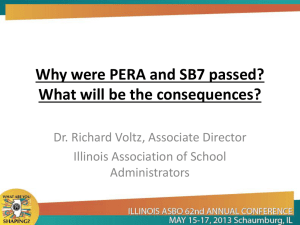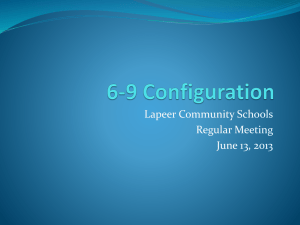SY 201 Sociology of Families
advertisement
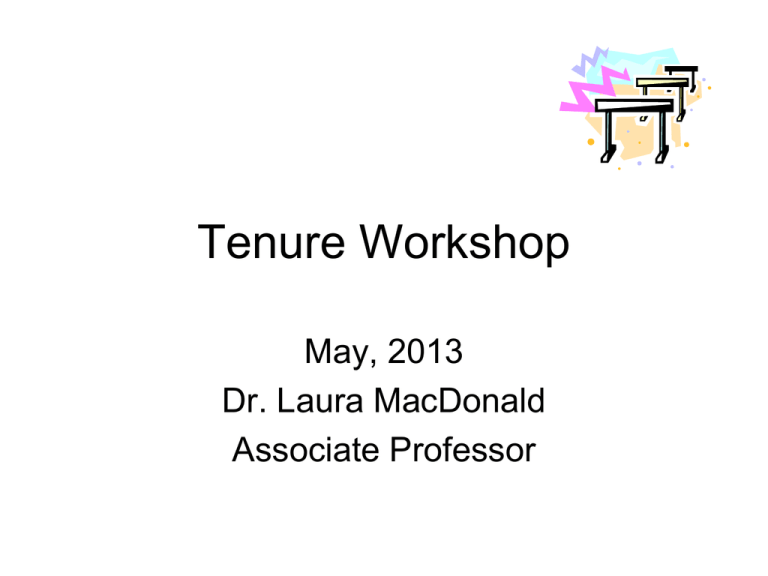
Tenure Workshop May, 2013 Dr. Laura MacDonald Associate Professor Agenda • Introduction • The Process – Timing – Steps in process • The Criteria – Teaching – Research – Service UNDERSTANDING THE PROCESS: SECTION 15 Tenure and Promotion • When you are granted tenure, you are also promoted to Associate (15.7.6). – One application covers both. • You may only be considered once for tenure. TIMING Extensions and other matters Timing • You must be considered for tenure by the third year of your Candidacy appointment.(s15.3) – You will receive notification from the Dean at the beginning of your 3rd year of Candidacy. • However, clock may be extended for reasons outlined in CA. – A one year extension of the tenure clock can also be requested at the probationary stage (13.2.2) – Parental, maternity or care leaves. Probationary 1 year extension • A one year extension of the tenure clock can also be requested at the probationary stage – More time is better than less – Most people cannot tell as this point in career, if will need extra time or not, so most are applying for extension Maternity/Parental Extensions • Clock stops for maternity/parental and associated leaves (Article 32) and tenure clock can be extended by one year for those who have taken maternity or parental leave (32.6.3) – Must apply (remember this) for extension – Essentially, year does not count, so extra year does not increase expectations – No negative effects!! Family/Care Extensions • tenure clock can be extended by one year for those who have requested a reduced load for elder or child care reasons (Article 20) – Can only use once during candidacy/provisional appointment – Extra year does not increase expectations, so no negative effects. Going up Early • Hurdle is same, just less time to achieve it • Committee Members wonder what is the rush? • Will decrease # of CDI you get over lifetime, so can affect total salary earned. • Risk: only get one shot at this! • Successful situations for going up early: – Appointment to tenure track with already strong record of accomplishments and have achieved more since joining WLU – Have had several extensions due to mat/pat leaves, have enough to meet hurdle Steps in the Process Candidate applies to Chair of Dept. APC by Sept 15. [cc the Dean] Dept. APC meet and recommends to SPAT Stage 1 Dept. SPAT meets and recommends to President Stage 2 SPAT President recommends to Board of Governors Stage 3 President & B of G Stage 1- Department Candidate applies to Chair of Dept. APC by Sept 15. [cc the Dean] DAPC may request additional info (S15.4.3) Candidate receives invitation to appear (S15.4.3) •Most do not •Some appear with WLUFA rep •Some submit additional information by letter DAPC may request you to respond if any negative information is presented (S15.4.3) -good to appear and bring WLUFA rep Dept. APC meets and makes it recommendation & report to SPAT by Oct 15. S15.4.3, .5 & .6 Candidate receives copy of letter – decision, vote count, reasons •Contact WLUFA if negative votes DAPC Procedures S 15.4.3 • Member shall be • invited to appear before DAPC to present any further evidence and/or supporting information, oral and/or written, he/she deems appropriate. • DAPC shall request from the Member any further information it deems necessary or relevant to make a recommendation. • The Member shall have the right to be accompanied by a representative of his/her choice. DAPC Procedures S 15.4.3 • DAPC shall assess the Member's overall record of performance using the appropriate conditions and criteria pursuant to this Article. – In the event any negative information is presented to the Committee, the Member shall be provided with such information in writing and shall be provided (prior to any vote being taken by the Committee) with a reasonable opportunity of responding to such negative information. • A recommendation of the DAPC shall be based only on documentation presented pursuant to this clause and clauses 15.4.1, and 15.4.2. DAPC Procedures S15.4.3 • The report of the DAPC shall include – a numerical record of the vote upon which the recommendation is based – a written statement of reasons for that recommendation. • If the recommendation is not unanimous, the statement shall include reasons supporting and opposing the recommendation. – Such reasons shall relate only to the conditions and criteria for tenure and promotion. SPAT receives DAPC letter/report by Oct 15. Stage 2 - SPAT SPAT may request additional info (S15.5.4) Candidate receives invitation to appear or provide more information(S15.5.4) •Most decline •Some appear with WLUFA rep (if problems with DAPC report •Some submit additional more information by letter SPAT meets and makes it recommendation & report to President by Nov 15. SPAT may request you to respond if any negative information is presented (S15.5.4) -good to appear and bring WLUFA rep Candidate receives copy of letter – decision, vote count, reasons •Contact WLUFA if negative recommendation SPAT • Chaired by VP Academic • 7 voting members – VP,Academic – Dean of member’s unit – 5 tenured faculty, elected by Faculty Council • 2 non-voting members – VP, Research – Equity Rep. SPAT-process S15.5.2 & .3 • Member’s chair – presents the DAPC recommendation to SPAT – Answers any questions SPAT members have • VP Research – Provides opinion on research record • Equity Rep – Ensures correct process is followed, • E.g. mat/pat leaves are recognized, no conflict of interests, etc. SPAT Procedures • SPAT shall request from the Member any further information it deems necessary to make a recommendation. • Member shall be invited to appear before the Committee or, if the Member prefers, he/she shall be allowed to make written submissions for the purpose of presenting any further information, oral and/or written, he/she deems appropriate. SPAT Procedures • In the event any negative information is presented to the Committee, the Member shall be provided with such information in writing and shall be provided (prior to any vote being taken by the Committee) with a reasonable opportunity of responding to such negative information. • the Member shall have the right to be accompanied by a representative of his/her choice. SPAT Recommendation • 15.5.5 SPAT’s recommendation shall be based only on documentation presented and the evidence heard, and on the recommendation of the DAPC – No hearsay allowed! – Is not a rubber stamp of DAPC, considers criteria, etc. • Recommendation provides reasons as well as a numerical record of all votes Stage 3 – President and B of G SPAT meets and makes it recommendation & report to President by Nov 15. President makes his recommendation to Board of Governors S15.6.3 Candidate receives copy of letter – decision, vote count, reasons •Contact WLUFA if negative recommendation Board of Governors approves. Subject to grievance at this point S15.6.3 Final notification letter Dec.15 CRITERIA S15.7 How are candidates evaluated? What should be included in your application? S 15.1.1. • Promotion in rank from Assistant Professor to Associate Professor is – a recognition of the Member's growth and development as a teacher and scholar, and of his or her service to the University and the academic community. S15.7.4 • The criteria for tenure are: (a) a satisfactory record as a teacher; (b) a satisfactory record of scholarly activity and achievement, or creative work in the performing and fine arts, to be normally demonstrated by presentation or publication in a credible academic, artistic or professional forum; (c) a satisfactory record of academic, professional and university community service. Criteria S15.7.1 • Teaching • Scholarship • Service Teaching (S15.7.2 (a)) • A requirement for tenure or for promotion to any rank is • demonstrated competence and responsibility in teaching and • a commitment to the facilitation of student learning • including – contributions to the development of curriculum and programs of study within a Member’s academic unit or sub-unit. • Teaching performance which is superior to the necessary requirement counts additionally in the candidate's favour Teaching - examples • Teaching evaluations – Teaching awards – nominations, winning • Courses taught and developed • Ways you facilitate student learning – Mentor (e.g. case competitions) – Independent studies – Graduate supervision – Program development • Growth/improvement in teaching Scholarship S15.7.2 (b) • A requirement for tenure or for promotion to any rank is – evidence of scholarly activity and achievement, – or creative work in the performing and fine arts, – and recognition of one's work by academic peers. Evidence of scholarship (i) a commitment to continuing growth in the Member's academic discipline, and to intellectual and/or artistic pursuits generally, • receipt of research and publication grants • and academic research activity which has resulted in the presentation or publication of findings in a credible academic forum. Examples of (i) – and how they are perceived • Grants • Internal • External • Peer reviewed publications • Journal articles • Books • Peer reviewed conference proceedings • Peer reviewed conference presentations • Professional journals • Non-peer reviewed outlets Evidence of scholarship (ii) imaginative and innovative contributions in the performing and creative arts such as – commissioned works, – publication of artistic and literary works and musical compositions, – presentations, performances and shows presented in a credible artistic forum. Evidence of scholarship (iii) publications and/or presentations in a credible professional forum including – the publication and/or airing of researchdependent works of Journalism in a credible journalistic forum; Evidence of scholarship (iv) scholarship in teaching, including – research, publications and academic presentations or workshops on teaching within universities and/or scholarly disciplines; (v) publications, including textbooks and case studies, which may not result from original research but which constitute valuable or creditable additions to the discipline. Evidence of scholarship (vi) scholarly activity derived from the Member's expertise and recognition by one's peers including: – book reviews, – principal editorship of a journal, – the refereeing of manuscripts and proposals for publishers, periodicals, and research agencies, – and service as external examiners on graduate theses. What is satisfactory evidence of scholarship? • Quality vs. Quantity – Journal rankings – Citations, Impact – Grants – Record, pipeline, etc. • Recognition by peers – Reviewing, editorial boards, etc • Depends on field and timeline Academic, Professional and University Community Service • A consideration for tenure or promotion to any rank is evidence of active participation in the corporate life of the University community. Such contributions include – service on University and Association committees, – assistance and leadership in departmental administration, – contributions to the intellectual and cultural life of the campus. Academic and Professional Service • academic and professional service includes: • contributions to professional or learned societies through service on the government or other commissions in a professional capacity, • consulting work which involves more than the routine application of the existing body of knowledge, • and contributions in a professional capacity to the community-at-large and to cultural, community and service organizations. Tenure decision –S 15.7.4 • tenure shall be granted when there is – consistent evidence of satisfactory academic performance, – demonstrated professional growth, and – the promise of future development. • Satisfactory teaching, scholarship and service • The committee weighs each element and your total package to decide – A demonstrated record of excellence in teaching may be used to lessen the usual standards required in scholarship – an exceptional record of scholarly or creative work may be used to lessen the standards usually applied under criteria (a) [teaching] and (c) [service]. YOUR APPLICATION What should you include? Application: S 15.4.1 • The application shall be accompanied by – a curriculum vitae, – a copy of all scholarly publications listed in the curriculum vitae, – a teaching dossier (S 31.6) – such other documentation as the Member considers as evidence of fulfillment of the criteria. Elements of Application • • • • • The Letter of application CV Research dossier Teaching dossier Pointers The Letter of Application Purpose: explain how you fulfill the criteria for tenure • A summary of highlights and achievements – Suggested length – 2-3 pages • Refer reader to research programme or teaching dossier as necessary – A way of linking your CV to the 3 criteria in CA • Also, link your achievements to where your work is going, and how you will continue to build on these achievements – your future potential. • and to address anything that might raise questions in your package The Letter of Application Structure: • Address all 3 criteria in your letter, have a section for each: – 1 to 2 paragraphs (each) for teaching and service – Paragraphs for research should summarizing what you had when you came, what you have done since, your future research plans. • Highlight quality/reputation of journals, high citation counts, positive reviews of your work, exceptional service to the university or academic community, awards and nominations etc, • Refer to research programme, accomplishments, current projects and future plans • If you are arguing excellence in teaching, expand that section. CV • The quantitative summary of your career • Clarity, organization, consistency and readability are important • See sample • What you did before Laurier still counts, just in a different way than what you have done since coming here – Indicates research program, record of past good indication of future, but will focus more on what you have done since joining WLU CV • Important to not annoy the evaluator – Include page numbers (e.g. 201-241) – Indicate role if multiple authors • E.g. equal contribution, 1st author more, etc. • Indicate if authors are your students or thesis supervisor – (can simply note e.g. bold indicates students) – Do not pad! • If you presented the same paper three times, list it as one line on CV, with details following • If you presented paper and then published, it is fine to have it under presentations and then journal articles (that is not padding). CV • Important to not annoy the evaluator – Be clear about whether it is peer reviewed or not – Include in appropriate segment • Published (or forthcoming) • Have segments for – Papers under review » Indicate status (1st, 2nd round, etc), journal, etc. – Completed working papers » If already presented, just list in that segment. » If submitted to conference, etc, indicate that – Work in progress » Indicate status(e.g. grant received, data collection, etc) – For books, be honest and include documents to show stage it is at (invited, proposal, accepted manuscript, etc) Research Dossier Required: • a copy of all publications Recommended: – Research statement/programme • Overall research statement • How past, current and future projects fit together within your programme of research – include any other documentation that provides evidence of achievement or potential • E.g. book contracts, copies of emails from publishers, reviews of your work, journal rankings, citation counts, Teaching Dossier – Teaching Dossier • See CA Article 31.6.2 for items to include • the Dossier shall provide a record of teaching with accompanying documents for a minimum of three (3) years and normally not more than seven (7) years preceding the date of application. Per 31.6.2 items that must be included: (i) List of courses taught (course number, title, credit value, and enrolment) (ii) The outline for each course listed above (iii) List of individual student projects supervised, if any (e.g. honours theses or similar individually-supervised projects, master's or doctoral theses), whether completed or in progress, and the nature of the faculty member's involvement (principal advisor, second reader, external examiner, etc.) at Laurier or elsewhere; (iv) The student teaching evaluations in a Member's Official File shall be considered as part of the Teaching Dossier. – A Member may wish to place additional copies of the teaching evaluations in the Dossier, but there is no requirement to do so. Per 31.6.2 items that may be included: (i) In addition to the course outlines provided above, instructions for assignments, reading lists, final examinations, or other course-related materials, and information about the programs of study of students enrolled in the courses; (ii) Course evaluations conducted by the Member; any comments the Member may wish to make about these evaluations, or about the University teaching evaluations under item (a) (iv) above; - Useful to provide a summary of teaching evaluations by course (in whatever way is informative, by year, course, etc) (iii) Information from students, including informal student evaluations, letters, and testimonials; - Useful to provide testimonials if trying to show teaching excellence Per 31.6.2 items that may be included: (iv) A statement of the Member's pedagogical goals and objectives; - Very useful to indicate your teaching style, goals and overall commitment to student learning - Especially if you have experimented with different styles - If teaching evaluations vary across time or courses Per 31.6.2 items that may be included: (v) A statement of the Member's involvement in professional development in the pedagogical area. Here one might describe steps taken to improve one's own teaching, such as • participating in seminars, work-shops, or professional meetings concerned with the improvement of teaching • publishing articles, commentaries or reviews related to teaching • receiving instructional development grants • attempting instructional innovations and evaluating their effectiveness • evidence of special assistance given to colleagues in the area of improvement of teaching (e.g. through the Mentorship program), or activities connected with the training and orientation of teaching assistants Particularly important if your teaching was less than satisfactory and you have worked on improving it or if it is still borderline. Per 31.6.2 items that may be included: • (vi) Description of duties connected with – the coordination of multi-sectioned, sequenced, or otherwise interrelated courses, and – with the direction and coordination of programs of studies including the academic counseling of students; • (vii) Evidence of contribution to course, program, or general curriculum development. – Here one might list membership on committees concerned with teaching or curriculum matters, and describe one's involvement in the design of new courses, development of new programs, etc.; – Especially relevant if trying to prove teaching dedication and excellence Per 31.6.2 items that may be included: (viii) Information on a professor's contribution to the academic and cultural life of students (e.g., assistance with student clubs, special events, student conferences, exchanges, off-campus trips, etc.) (ix) Evidence of outstanding achievement by one's students (e.g. bibliographical information pertaining to publications by students on course-related work); (x) Description of honours received as a result of teaching excellence (e.g. the awarding of or nomination for distinguished teaching awards at the university, provincial, or national level, invitations to teach for outside agencies or to act as advisor for development of educational programs); (xi) Description of activities concerned with high school liaison; (xii) Other material that the Member deems relevant. Pointers • Think about this as the presentation of your case. • Make it clear, accessible, well-organized and complete for your readers • There are no external referees commenting on the importance of your work, so it is your job to make sure that this is clear, and that everything the committees need to assess your case is included. • The committees can not comment on or assess anything that isn’t in the application package, even if it would help you. MANAGING THE PROCESS Within your unit: • When putting together your application seek advice from your Chair and Dean. • Provide them with draft copies of your letter and CV well in advance and ask for feedback • Consider asking respected colleagues for copies of their tenure application letters to use as models. • Consider asking a recent tenured colleague to review your materials – Make sure you communicate with your chair during the tenure process and advise him or her of any additions or changes to your CV that occur after Sept 15th. Strategies • If these are early days for you, think about where you put your energies • Service is important, but it won’t mitigate shortcomings in research or teaching. • Prioritize the preparation of peer-reviewed journal articles or books, whatever counts the most as “research” in your discipline • Try to ensure continuity of your pipeline – Have conference presentations, grant apps, published papers/books (want to see consistency of effort/output) Strategies to Help • Focus on research output – quality & quantity – Outlets & pipeline • Focus on ensuring adequate teaching quality • Service is important, but does not mitigate for other deficiencies

